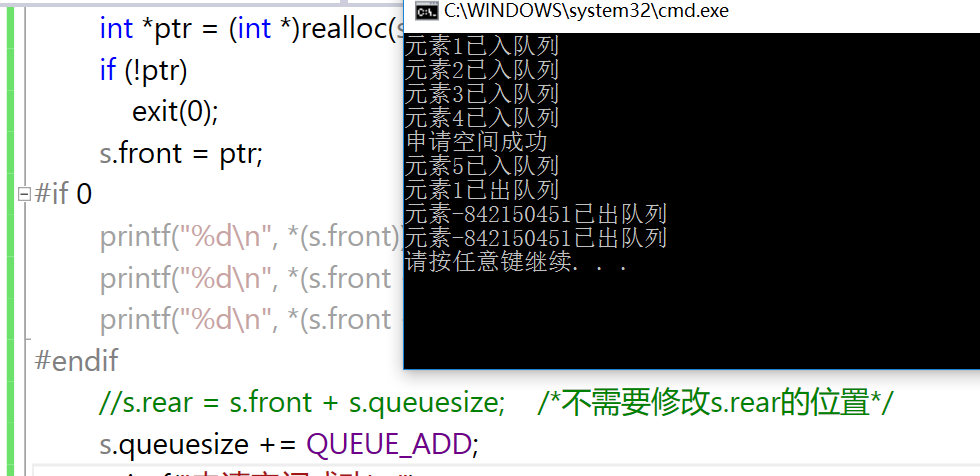33,311
社区成员
 发帖
发帖 与我相关
与我相关 我的任务
我的任务 分享
分享#include <iostream>
#define QUEUE_INIT_SIZE 4
#define QUEUE_ADD 10
typedef struct {
int *rear;
int *front;
int queuesize;
}SqQueue;
void InitQueue(SqQueue &s) {
s.front = (int *)malloc(sizeof(int));
if (!s.rear) exit(0);
s.rear = s.front;
s.queuesize = QUEUE_INIT_SIZE;
}
void EnQueue(SqQueue &s, int e) {
if (s.rear - s.front >= s.queuesize)
{
int *ptr = (int *)realloc(s.front, (s.queuesize + QUEUE_ADD) * (sizeof(int)));
if (!ptr) exit(0);
s.front = ptr;
/*printf("%d\n", *(s.front ));
printf("%d\n", *(s.front+1));
printf("%d\n", *(s.front + 1+1));*/
s.rear = s.front + s.queuesize;
s.queuesize += QUEUE_ADD;
printf("申请空间成功\n");
}
*s.rear = e;
s.rear++;
printf("元素%d已入队列\n", e);
}
void DeQueue(SqQueue &s) {
if (s.front == s.rear)
{
printf("队列为空\n");
exit(0);
}
int e = *(s.front);
s.front++;
printf("元素%d已出队列\n", e);
}
int main() {
SqQueue s;
InitQueue(s);
EnQueue(s, 1);
EnQueue(s, 2);
EnQueue(s, 3);
EnQueue(s, 4);
EnQueue(s, 5);
DeQueue(s);
DeQueue(s);
DeQueue(s);
return 0;
}
#include <iostream>
#include <cstdio>
#include <cstdlib>
#define QUEUE_INIT_SIZE 4
#define QUEUE_ADD 10
typedef struct {
int *rear;
int *front;
int queuesize;
}SqQueue;
void InitQueue(SqQueue &s)
{
s.front = (int *)malloc(sizeof(int));
if (!s.rear)
exit(0);
s.rear = s.front;
s.queuesize = QUEUE_INIT_SIZE;
}
void EnQueue(SqQueue &s, int e)
{
if (s.rear - s.front >= s.queuesize) {
int *ptr = (int *)realloc(s.front, (s.queuesize + QUEUE_ADD) * (sizeof(int)));
if (!ptr)
exit(0);
s.front = ptr;
#if 0
printf("%d\n", *(s.front ));
printf("%d\n", *(s.front+1));
printf("%d\n", *(s.front + 1+1));
#endif
//s.rear = s.front + s.queuesize; /*不需要修改s.rear的位置*/
s.queuesize += QUEUE_ADD;
printf("申请空间成功\n");
}
*s.rear = e;
s.rear++;
printf("元素%d已入队列\n", e);
}
void DeQueue(SqQueue &s) {
if (s.front == s.rear)
{
printf("队列为空\n");
exit(0);
}
int e = *(s.front);
s.front++;
printf("元素%d已出队列\n", e);
}
int main() {
SqQueue s;
InitQueue(s);
EnQueue(s, 1);
EnQueue(s, 2);
EnQueue(s, 3);
EnQueue(s, 4);
EnQueue(s, 5);
DeQueue(s);
DeQueue(s);
DeQueue(s);
return 0;
}#include <iostream>
#include <cstdio>
#include <cstdlib>
#define QUEUE_INIT_SIZE 4
#define QUEUE_ADD 10
typedef struct {
int *rear;
int *front;
int *orig;
int queuesize;
}SqQueue;
void InitQueue(SqQueue &s)
{
s.orig = (int *)malloc(QUEUE_INIT_SIZE * sizeof(int));
if (!s.orig)
exit(0);
s.rear = s.front = s.orig;
s.queuesize = QUEUE_INIT_SIZE;
}
void EnQueue(SqQueue &s, int e)
{
if (s.rear - s.orig >= s.queuesize) {
int *ptr = (int *)realloc(s.orig, (s.queuesize + QUEUE_ADD) * (sizeof(int)));
if (!ptr)
exit(0);
s.orig = ptr;
s.queuesize += QUEUE_ADD;
printf("申请空间成功\n");
}
*s.rear = e;
s.rear++;
printf("元素%d已入队列\n", e);
}
void DeQueue(SqQueue &s) {
if (s.front == s.rear)
{
printf("队列为空\n");
return;
}
int e = *(s.front);
s.front++;
printf("元素%d已出队列\n", e);
}
int main() {
SqQueue s;
InitQueue(s);
EnQueue(s, 1);
EnQueue(s, 2);
EnQueue(s, 3);
EnQueue(s, 4);
EnQueue(s, 5);
DeQueue(s);
DeQueue(s);
DeQueue(s);
free(s.orig);
return 0;
}
//元素1已入队列
//元素2已入队列
//元素3已入队列
//元素4已入队列
//申请空间成功
//元素5已入队列
//元素1已出队列
//元素2已出队列
//元素3已出队列
//
 这是您修改后代码的运行截图,还是会出现野指针问题,还有就是我觉得应该需要修改s.rear的地址,因为s.front已经指向了新地址,如果s.rear不修改的话,新入队的元素就无法通过s.front++来出队。
如有不正确的地方,请您指正。[/quote]
没看出有啥问题,在我的PC上测试都是正常的。
这是您修改后代码的运行截图,还是会出现野指针问题,还有就是我觉得应该需要修改s.rear的地址,因为s.front已经指向了新地址,如果s.rear不修改的话,新入队的元素就无法通过s.front++来出队。
如有不正确的地方,请您指正。[/quote]
没看出有啥问题,在我的PC上测试都是正常的。 这是您修改后代码的运行截图,还是会出现野指针问题,还有就是我觉得应该需要修改s.rear的地址,因为s.front已经指向了新地址,如果s.rear不修改的话,新入队的元素就无法通过s.front++来出队。
如有不正确的地方,请您指正。
这是您修改后代码的运行截图,还是会出现野指针问题,还有就是我觉得应该需要修改s.rear的地址,因为s.front已经指向了新地址,如果s.rear不修改的话,新入队的元素就无法通过s.front++来出队。
如有不正确的地方,请您指正。